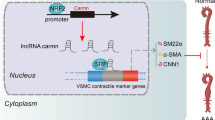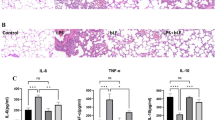Abstract
MicroRNAs (miRNAs) are short endogenous noncoding RNAs regulating protein translation. However, the specific mechanism by which miR-181b influences sepsis via high-mobility group box-1 protein (HMGB1) still remains unknown. Thus, the aim of this study is to investigate the mechanism of miR-181b in regulating inflammatory response in sepsis-induced myocardial injury through targeting high-mobility group box-1 protein (HMGB1). Through cecal ligation and puncture (CLP), the rat model of sepsis was established. Then, the effect of altered expression of miR-181b and HMGB1 on cardiomyocytes was investigated. The positive expression rate of HMGB1, concentration of inflammatory factors, and serum myocardial enzyme of myocardial tissues were determined. Besides, the binding site between miR-181b and HMGB1 was determined by bioinformatics information and dual-luciferase reporter gene assay. The expression of related genes in cells of each group was determined by RT-qPCR and western blot analysis, and the apoptosis rate of transfected cells in each group was determined by TUNEL assay. HMGB1 expression and inflammatory factors were significantly increased in myocardial tissue of rats with sepsis. Cell morphology and the infiltration of inflammatory cells were significantly improved by overexpression of miR-181b. miR-181b directly targeted HMGB1, and downregulation of HMGB1 reduced inflammatory factors and myocardial injury and inhibited cardiomyocyte apoptosis in sepsis. This present study suggests that miR-181b decreased inflammatory factors and reduced myocardial injury in sepsis through downregulation of HMGB1. Thus, a better understanding of this process may aid in the development of novel therapeutic agents in sepsis.




Similar content being viewed by others
References
Rhodes, A., L.E. Evans, W. Alhazzani, M.M. Levy, M. Antonelli, R. Ferrer, et al. 2017. Surviving Sepsis Campaign: international guidelines for management of sepsis and septic shock: 2016. Crit Care Med 45 (3): 486–552.
Delano, M.J., and P.A. Ward. 2016. Sepsis-induced immune dysfunction: can immune therapies reduce mortality? J Clin Invest 126 (1): 23–31.
Lu, Z.Q., J.X. Lu, and Y.J. Deng. 2015. Glucocorticoids offer protection against myocardial injury in a murine model of sepsis. Int J Clin Exp Med 8 (8): 12211–12218.
Zhang, X., S. Dong, Y. Qin, and X. Bian. 2015. Protective effect of erythropoietin against myocardial injury in rats with sepsis and its underlying mechanisms. Mol Med Rep 11 (5): 3317–3329.
Zhang, M., X. Wang, B. Bai, R. Zhang, Y. Li, and Y. Wang. 2016. Oxymatrine protects against sepsis-induced myocardial injury via inhibition of the TNF-alpha/p38-MAPK/caspase-3 signaling pathway. Mol Med Rep 14 (1): 551–559.
Sun, X., B. Icli, A.K. Wara, N. Belkin, S. He, L. Kobzik, et al. 2012. MicroRNA-181b regulates NF-kappaB-mediated vascular inflammation. J Clin Invest 122 (6): 1973–1990.
O’Connell, R.M., D.S. Rao, A.A. Chaudhuri, and D. Baltimore. 2010. Physiological and pathological roles for microRNAs in the immune system. Nat Rev Immunol 10 (2): 111–122.
Peng, Z., J. Li, Y. Li, X. Yang, S. Feng, S. Han, et al. 2013. Downregulation of miR-181b in mouse brain following ischemic stroke induces neuroprotection against ischemic injury through targeting heat shock protein A5 and ubiquitin carboxyl-terminal hydrolase isozyme L1. J Neurosci Res 91 (10): 1349–1362.
McClure, C., M.B. McPeak, D. Youssef, Z.Q. Yao, C.E. McCall, and M. El Gazzar. 2017. Stat3 and C/EBPbeta synergize to induce miR-21 and miR-181b expression during sepsis. Immunol Cell Biol 95 (1): 42–55.
Hutchison, E.R., E.M. Kawamoto, D.D. Taub, A. Lal, K. Abdelmohsen, Y. Zhang, et al. 2013. Evidence for miR-181 involvement in neuroinflammatory responses of astrocytes. Glia 61 (7): 1018–1028.
Lu, F., J. Zhang, M. Ji, P. Li, Y. Du, H. Wang, et al. 2014. miR-181b increases drug sensitivity in acute myeloid leukemia via targeting HMGB1 and Mcl-1. Int J Oncol 45 (1): 383–392.
Liu, Y., X. Hu, D. Xia, and S. Zhang. 2016. MicroRNA-181b is downregulated in non-small cell lung cancer and inhibits cell motility by directly targeting HMGB1. Oncol Lett 12 (5): 4181–4186.
Gentile, L.F., and L.L. Moldawer. 2014. HMGB1 as a therapeutic target for sepsis: it’s all in the timing! Expert Opin Ther Targets 18 (3): 243–245.
Yang, H., H. Wang, S.S. Chavan, and U. Andersson. 2015. High mobility group box protein 1 (HMGB1): the prototypical endogenous danger molecule. Mol Med 21 (Suppl 1): S6–S12.
Hubbard, W.J., M. Choudhry, M.G. Schwacha, J.D. Kerby, L.W. Rue, K.I. Bland 3rd, et al. 2005. Cecal ligation and puncture. Shock 24 (Suppl 1): 52–57.
Kong, W., K. Kang, Y. Gao, H. Liu, X. Meng, Y. Cao, et al. 2018. GTS-21 protected against LPS-induced sepsis myocardial injury in mice through alpha7nAChR. Inflammation 41 (3): 1073–1083.
Wang, H., M.F. Ward, and A.E. Sama. 2009. Novel HMGB1-inhibiting therapeutic agents for experimental sepsis. Shock 32 (4): 348–357.
Wang, H., M.F. Ward, and A.E. Sama. 2014. Targeting HMGB1 in the treatment of sepsis. Expert Opin Ther Targets 18 (3): 257–268.
Huang, W., Y. Tang, and L. Li. 2010. HMGB1, a potent proinflammatory cytokine in sepsis. Cytokine 51 (2): 119–126.
Gao, Z., L. Wang, J. Wang, F. Yang, and J. Qu. 2017. Molecular mechanism of miR-181b in heart disease due to pregnancy-induced hypertension syndrome. Exp Ther Med 14 (4): 2953–2959.
Li, D., W. Jian, C. Wei, H. Song, Y. Gu, Y. Luo, et al. 2014. Down-regulation of miR-181b promotes apoptosis by targeting CYLD in thyroid papillary cancer. Int J Clin Exp Pathol 7 (11): 7672–7680.
Yang, L., Y.L. Wang, S. Liu, P.P. Zhang, Z. Chen, M. Liu, et al. 2014. miR-181b promotes cell proliferation and reduces apoptosis by repressing the expression of adenylyl cyclase 9 (AC9) in cervical cancer cells. FEBS Lett 588 (1): 124–130.
Faridvand, Y., S. Nozari, V. Vahedian, N. Safaie, M. Pezeshkian, P. Haddadi, et al. 2019. Nrf2 activation and down-regulation of HMGB1 and MyD88 expression by amnion membrane extracts in response to the hypoxia-induced injury in cardiac H9c2 cells. Biomed Pharmacother 109: 360–368.
Li, Q., Z.M. Li, S.Y. Sun, L.P. Wang, P.X. Wang, Z. Guo, et al. 2018. PARP1 interacts with HMGB1 and promotes its nuclear export in pathological myocardial hypertrophy. Acta Pharmacol Sin.
Zhou, Y., Y. Li, and T. Mu. 2015. HMGB1 neutralizing antibody attenuates cardiac injury and apoptosis induced by hemorrhagic shock/resuscitation in rats. Biol Pharm Bull 38 (8): 1150–1160.
Luo, P., Y. Zhu, M. Chen, H. Yan, B. Yang, X. Yang, et al. 2018. HMGB1 contributes to adriamycin-induced cardiotoxicity via up-regulating autophagy. Toxicol Lett 292: 115–122.
Kim, J.E., W. Lee, S. Yang, S.H. Cho, M.C. Baek, G.Y. Song, et al. 2018. Suppressive effects of rare ginsenosides, Rk1 and Rg5, on HMGB1-mediated septic responses. Food Chem Toxicol 124: 45–53.
Dai, C., X. Xiao, D. Li, S. Tun, Y. Wang, T. Velkov, et al. 2018. Chloroquine ameliorates carbon tetrachloride-induced acute liver injury in mice via the concomitant inhibition of inflammation and induction of apoptosis. Cell Death Dis 9 (12): 1164.
Do, T., R. Tan, M. Bennett, M. Medvedovic, A.A. Grom, N. Shen, et al. 2018. MicroRNA networks associated with active systemic juvenile idiopathic arthritis regulate CD163 expression and anti-inflammatory functions in macrophages through two distinct mechanisms. J Leukoc Biol 103 (1): 71–85.
Ghorbani, S., F. Talebi, W.F. Chan, F. Masoumi, M. Vojgani, C. Power, et al. 2017. MicroRNA-181 variants regulate T cell phenotype in the context of autoimmune neuroinflammation. Front Immunol 8: 758.
Acknowledgments
We acknowledge and appreciate our colleagues for their valuable efforts and comments on this paper.
Author information
Authors and Affiliations
Contributions
Lida Zhi, Haifeng Wang, and Lan Ling designed the study. Yihuan Deng, Chengdong Gu, and Lan Ling collated the data, designed and developed the database, carried out data analyses, and produced the initial draft of the manuscript. Lan Ling contributed to drafting the manuscript. All authors participated in the revised manuscript, and have read and approved the final submitted manuscript.
Corresponding author
Ethics declarations
Competing Interests
The authors declare that they have no conflict of interest.
Additional information
Publisher’s Note
Springer Nature remains neutral with regard to jurisdictional claims in published maps and institutional affiliations.
Rights and permissions
About this article
Cite this article
Ling, L., Zhi, L., Wang, H. et al. MicroRNA-181b Inhibits Inflammatory Response and Reduces Myocardial Injury in Sepsis by Downregulating HMGB1. Inflammation 44, 1263–1273 (2021). https://doi.org/10.1007/s10753-020-01411-w
Received:
Revised:
Accepted:
Published:
Issue Date:
DOI: https://doi.org/10.1007/s10753-020-01411-w




